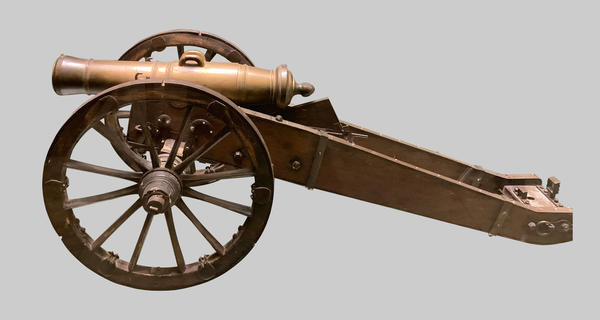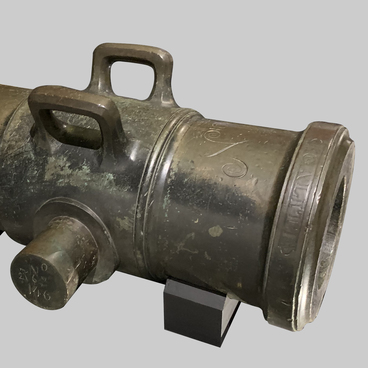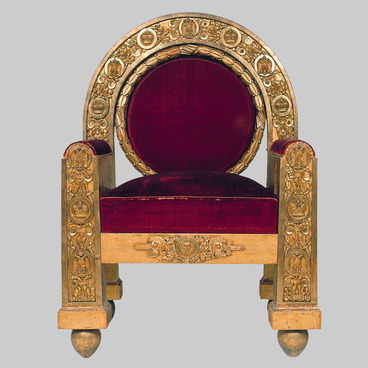During Napoleonic Wars Russian artillery underwent a number of organizational changes in order to enhance effectiveness of its use in new conditions. In the early 19th century Russia developed a new complex system of artillery armament, while Russian industry was capable of satisfying the army needs thus making it possible to fully abandon foreign-made cannons.
The reforms begun back in the late 18th century by Paul I continued under the guidance of General Aleksey Andreyevich Arakcheyev (1769—1834), a Count since 1799. He enjoyed the confidence of Emperors Paul I and Alexander I, which made it possible to transform the entire system of Russian artillery. Its main advantages were now simplified and uniform artillery weapons.
After the reforms, field artillery consisted of bronze pieces of two types: guns and licornes manufactured in the arsenal workshops of Bryansk and Saint Petersburg. While guns firing cannon balls and canister were practically no different from the enemy counterparts, the designs of licornes as a relatively new type of artillery pieces were changing constantly combining the capabilities and advantages of both the gun and the howitzer.
Through reducing the barrel length and wall thickness gunsmiths managed to reduce the weight of cannons. After 1804 they were no more decorated ornately, only a few simple friezes and dolphin cannon handles were left intact. The designs of cannons were unified thus facilitating maintenance and repair.
It is generally assumed that licornes are the unique inventions of the Russian artillery thought, but by the time of Napoleonic Wars cannons of such design under various names were employed in the artillery of many European countries.
Licornes conducted flat- and high-trajectory fire with cannon balls, bombs, canister, high-explosive and incendiary grenades. They featured a high rate of fire and manoeuvrability and were named after a mythical beast uniсorn depicted on the coat of arms of the Shuvalovs, a Russian noble family of counts.
The weight of the ½ pood (18-pounder) licorne in the travelling position was about 1600 kg and it took 6 horses to carry it. From 1813, after horse batteries were formed, teams of 8 heavy draught horses were used. The licrorne’s standard allowance of ammunition had 120 rounds and was carried in three ammunition boxes, each on a separate cart drawn by three harnessed horses.
The reforms begun back in the late 18th century by Paul I continued under the guidance of General Aleksey Andreyevich Arakcheyev (1769—1834), a Count since 1799. He enjoyed the confidence of Emperors Paul I and Alexander I, which made it possible to transform the entire system of Russian artillery. Its main advantages were now simplified and uniform artillery weapons.
After the reforms, field artillery consisted of bronze pieces of two types: guns and licornes manufactured in the arsenal workshops of Bryansk and Saint Petersburg. While guns firing cannon balls and canister were practically no different from the enemy counterparts, the designs of licornes as a relatively new type of artillery pieces were changing constantly combining the capabilities and advantages of both the gun and the howitzer.
Through reducing the barrel length and wall thickness gunsmiths managed to reduce the weight of cannons. After 1804 they were no more decorated ornately, only a few simple friezes and dolphin cannon handles were left intact. The designs of cannons were unified thus facilitating maintenance and repair.
It is generally assumed that licornes are the unique inventions of the Russian artillery thought, but by the time of Napoleonic Wars cannons of such design under various names were employed in the artillery of many European countries.
Licornes conducted flat- and high-trajectory fire with cannon balls, bombs, canister, high-explosive and incendiary grenades. They featured a high rate of fire and manoeuvrability and were named after a mythical beast uniсorn depicted on the coat of arms of the Shuvalovs, a Russian noble family of counts.
The weight of the ½ pood (18-pounder) licorne in the travelling position was about 1600 kg and it took 6 horses to carry it. From 1813, after horse batteries were formed, teams of 8 heavy draught horses were used. The licrorne’s standard allowance of ammunition had 120 rounds and was carried in three ammunition boxes, each on a separate cart drawn by three harnessed horses.



